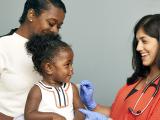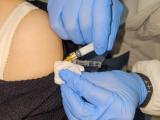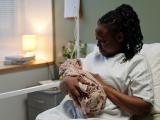Dec 13, 2002 (CIDRAP News) In a brief statement today, President George W. Bush announced that the government will begin giving smallpox shots to military and other government personnel in high-risk areas and to willing front-line healthcare workers.
The president said the government is not recommending the vaccine for the public for now but will try to make it available to those who demand it. An accompanying White House statement said an unlicensed vaccine could be available to the public sometime next spring.
As an example to military personnel who may be concerned about the vaccine's risks, Bush also said he will receive a smallpox shot himself. However, he said his family will not get the shot. He did not indicate how many people might receive the shots in the near future or when vaccinations would begin.
"Our government has no information that a smallpox attack is imminent, but it is prudent to be prepared for the possibility that terrorists . . . would use this disease as a weapon," the grim-looking president said in prefacing his televised announcement.
Noting that public health agencies began preparing for a smallpox vaccination program more than a year ago, he said, "America has stockpiled enough vaccine and is now prepared to inoculate our entire population in the event of a smallpox attack. Americans and anyone who would think of harming Americans can be certain that we are prepared to respond quickly to a smallpox emergency."
He continued, "Today I'm ordering additional steps to protect the health of our nation. I'm ordering that the military and other personnel who serve in high-risk parts of the world receive the smallpox vaccine. Men and women who would be on the front lines of a biological attack must be protected."
He added that the vaccine carries a "small risk" of serious adverse effects. "As commander-in-chief, I do not believe I can ask others to accept this risk unless I am willing to do the same," he said. "Therefore, I will receive the vaccine along with our military."
But he continued, "Given the current level of threat and the inherent risks of the vaccine, we have decided not to initiate a broader vaccine program for all Americans at this time." Accordingly, "Neither my family nor my staff will be receiving the vaccine, because we do not believe the vaccine is necessary for the general public."
Nonetheless, the government is preparing in case a broader vaccination program is needed in the future, he said. Noting that some people may demand the vaccine, he said, "Our public health agencies will work to accommodate those who want the vaccine."
Bush said his administration is also recommending vaccinations for volunteer teams of health personnel "who would be first on the scene in a smallpox emergency."
The president did not suggest how many military, other government, or health workers would be vaccinated in the first round the program, nor did he say when vaccinations will start. A White House statement said the military vaccination will begin "as soon as the vaccine is in place and medical training and troop education have been accomplished."
Recently submitted state plans call for the vaccination of about 450,000 front-line healthcare workers, the Centers for Disease Control and Prevention (CDC) said yesterday. Previous reports have suggested that about 500,000 military personnel could be vaccinated.
Previous reports also have suggested that up to 10 million healthcare workers and emergency personnel may eventually get the shots. But the White House statement said the number is not likely to be that high.
Regarding smallpox shots for the public, a White House question-and-answer statement released today said the Department of Health and Human Services (HHS) "is in the process of establishing an orderly process to make unlicensed vaccine available to those adult members of the general public without medical contraindications who insist on being vaccinated either in 2003, with an unlicensed vaccine, or in 2004, with a licensed vaccine." While this is not recommended, the statement says, "We expect to be able to make the unlicensed vaccine available to those who insist on being vaccinated sometime this spring." The statement did not specify whether the unlicensed vaccine would be old vaccine, grown on the skin of vaccinia-infected calves, or a new vaccine that is being produced in laboratory cell cultures. Acambis and Baxter Healthcare are collaborating to produce 209 million doses of cell culturegrown vaccine for HHS.
In view of some people's wish to get the shots, Bush decided that the best course is "to provide Americans with as much information as we can, help them weigh the risks, then let them decide for themselves," a White House statement says. It says state health departments, with CDC help, will set up vaccination clinics, the number of which will depend on the demand for the vaccine.
Concerning prevaccination screening, the White House said everyone who volunteers for the shot will be questioned in detail about their health and medical history and will be warned of the risks. If there is any sign of increased risk, the person will be referred for testing.
The CDC is enlisting an external review board to "review, in real time, vaccine adverse event reports and data, interpret findings, and provide guidance and advice for strengthening the overall safety of the program if needed," the White House said.
In other details, military personnel assigned to get the shots will include "certain emergency response and medical personnel" and other personnel involved in critical missions, the White House said. Civilian workers in certain US embassies will be offered both anthrax and smallpox shots on a voluntary basis.
Bush's announcement capped about 7 months of deliberations, during which the scope of the contemplated vaccination program expanded sharply. After a series of public forums on the issue, the federal Advisory Committee on Immunization Practices (ACIP) in June recommended pre-attack smallpox shots only for certain key public health workers and some staff members in designated hospitals who would deal directly with an outbreak. The committee chairman at the time estimated those workers would number only 10,000 to 20,000 nationwide.
Initial expectations were that the administration might announce a policy along those lines as early as July. But no announcement came, and press reports said some in the administration, including Vice President Dick Cheney, wanted to offer the vaccine to the public. On Oct 4, top federal health officials said they favored vaccinations for the public after most healthcare and emergency workers have been immunized. Two weeks later, on Oct 18, the ACIP revised its June recommendation and called for vaccination of a much larger corps of hospital workers, estimated at roughly 510,000 nationwide.
Also, in late September the CDC released a smallpox vaccination clinic guide and called on the states to prepare plans for rapid immunization of the public in the event of a smallpox outbreak. More recently, in late November, the CDC asked the states to quickly prepare plans for pre-attack immunization of frontline healthcare workers. Those plans were due Dec 9, one week after the deadline for the post-attack immunization plans.
Yesterday, HHS officials said they had completed an initial review of the state plans for pre-event vaccination of smallpox response teams and were pleased with what they found. As of yesterday, 49 states and four major cities had turned in their plans, the CDC said. (New York, Chicago, Los Angeles, and Washington, DC, have their own plans.)
"We are extremely pleased and quite impressed with the plans that have been submitted to CDC so far," HHS Secretary Tommy G. Thompson said in a news release. "It is obvious the state and local health departments and hospitals have stepped up to the plate under an extremely tight timetable to complete another critical step in our efforts to better protect Americans in the event of an intentional release of smallpox."
The CDC also said yesterday it had received post-attack vaccination plans from all 62 states, territories, and cities and was reviewing them.
The states were asked to be prepared to complete vaccinations of frontline health workers within 30 days after starting them. Some health officials have expressed doubts about the feasibility of this timetable. In a New York Times report today, C. Mack Sewell, New Mexico's state epidemiologist, said, "We felt that was not reasonable, and other states feel the same way." According to the story, Sewell and other experts said physicians need more time to gain experience in safely administering the vaccine and screening out people at risk for severe reactions to it.
The most serious reactions to the smallpox (vaccinia virus) inoculation include postvaccinial encephalitis, progressive vaccinia, and eczema vaccinatum, all of which can be fatal, and fetal vaccinia, which can lead to stillbirth. People with weakened immune systems are susceptible to progressive vaccinia, while those with a history of eczema or atopic dermatitis run a risk of eczema vaccinatum. The vaccinia virus can be contracted through close contact with recently vaccinated people, who may shed the virus for up to 3 weeks. In a report published last April, a group from the University of Michigan estimated that 25% of the US population would have to avoid the vaccine because they have risk factors or have routine close contact with others who have risk factors.
However, the ACIP has said the risk of transmission from hospital workers to patients is very low if the vaccination site is properly covered. Consequently, the committee has said that hospital workers should not have to be furloughed after getting the shot.
See also:
White House question-and-answer statement
http://www.whitehouse.gov/news/releases/2002/12/20021213-3.html
White House fact sheet
http://www.whitehouse.gov/news/releases/2002/12/20021213-1.html
Smallpox background information from CDC
http://www.whitehouse.gov/news/releases/2002/12/20021213-2.html


















